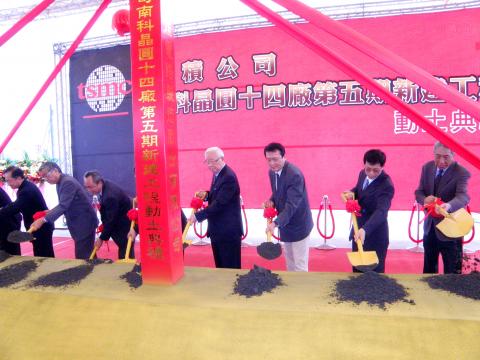Taiwan Semiconductor Manufacturing Co (TSMC, 台積電), the world’s largest contract chipmaker, will increase capital expenditure this year on the back of strong demand for semiconductors that go into tablet devices and mobile phones.
Demand for 28-nanometer (nm) technology is “very much stronger than we expected,” TSMC chairman and chief executive officer Morris Chang (張忠謀) said in Greater Tainan yesterday, referring to the company’s most-advanced production process at present.
This has spurred the company to commence production using 20nm process technology earlier than previously planned, he said.

Photo: Wang Chun-chung, Taipei Times
Chang made the remark as the company held a groundbreaking ceremony for a new manufacturing facility in the Southern Taiwan Science Park (南部科學園區). The Fab 14 Phase 5 manufacturing facility will be the firm’s second 20nm fab, which will begin commercial production in early 2014.
The first 20nm facility — Fab 12, Phase 6 at the Hsinchu Science Park (新竹科學園區) — will commence production next year.
“Our mission is to be the trusted technology and capacity provider for the global logic integrated circuit [IC] industry for years to come,” Chang said at the ceremony. “In fulfilling this mission, we further solidify TSMC’s and Taiwan’s indispensable position in the world semiconductor industry.”
“This groundbreaking for the Fab 14 Phase 5 facility represents TSMC’s capability to develop leading-edge technology, build advanced capacity and satisfy customer demand. It also lays the foundation for TSMC’s next wave of growth,” he added.
Demand for chips that go into mobile devices is increasing as more people use phones and tablet computers to access the Internet, play games and watch video. US smartphone users now exceed 100 million, Comscore Inc said last month.
TSMC is currently unable to meet demand for its 28nm technology, company spokesperson Elizabeth Sun (孫又文) said.
With phases 1, 2, 3 and 4 now in operation, the Fab 14 manufacturing facility has the capacity to produce 550,000 12-inch wafers per quarter, making it the world’s largest 12-inch fab, the company said.
The annual output value of Fab 14 phases 1 through 4 is estimated to exceed US$6 billion, and TSMC expects the combined annual revenue of Phase 5 and the planned Phase 6 to reach a similar scale.
During the past 15 years, TSMC has invested NT$450 billion (US$15.3 billion) in 8-inch and 12-inch fabs and back-end packaging in the science park, creating 8,000 jobs, Chang said.
The output value of TSMC’s fabs in the science park totaled NT$180 billion last year, accounting for 42 percent of the company’s total revenue, Chang said.
The Fab 14 facility currently has about 4,600 employees. TSMC will invest NT$350 billion in Fab 14 phases 5 and 6 facilities, creating another 4,500 jobs in the future, Chang said.

The US dollar was trading at NT$29.7 at 10am today on the Taipei Foreign Exchange, as the New Taiwan dollar gained NT$1.364 from the previous close last week. The NT dollar continued to rise today, after surging 3.07 percent on Friday. After opening at NT$30.91, the NT dollar gained more than NT$1 in just 15 minutes, briefly passing the NT$30 mark. Before the US Department of the Treasury's semi-annual currency report came out, expectations that the NT dollar would keep rising were already building. The NT dollar on Friday closed at NT$31.064, up by NT$0.953 — a 3.07 percent single-day gain. Today,

‘SHORT TERM’: The local currency would likely remain strong in the near term, driven by anticipated US trade pressure, capital inflows and expectations of a US Fed rate cut The US dollar is expected to fall below NT$30 in the near term, as traders anticipate increased pressure from Washington for Taiwan to allow the New Taiwan dollar to appreciate, Cathay United Bank (國泰世華銀行) chief economist Lin Chi-chao (林啟超) said. Following a sharp drop in the greenback against the NT dollar on Friday, Lin told the Central News Agency that the local currency is likely to remain strong in the short term, driven in part by market psychology surrounding anticipated US policy pressure. On Friday, the US dollar fell NT$0.953, or 3.07 percent, closing at NT$31.064 — its lowest level since Jan.

The Financial Supervisory Commission (FSC) yesterday met with some of the nation’s largest insurance companies as a skyrocketing New Taiwan dollar piles pressure on their hundreds of billions of dollars in US bond investments. The commission has asked some life insurance firms, among the biggest Asian holders of US debt, to discuss how the rapidly strengthening NT dollar has impacted their operations, people familiar with the matter said. The meeting took place as the NT dollar jumped as much as 5 percent yesterday, its biggest intraday gain in more than three decades. The local currency surged as exporters rushed to

PRESSURE EXPECTED: The appreciation of the NT dollar reflected expectations that Washington would press Taiwan to boost its currency against the US dollar, dealers said Taiwan’s export-oriented semiconductor and auto part manufacturers are expecting their margins to be affected by large foreign exchange losses as the New Taiwan dollar continued to appreciate sharply against the US dollar yesterday. Among major semiconductor manufacturers, ASE Technology Holding Co (日月光), the world’s largest integrated circuit (IC) packaging and testing services provider, said that whenever the NT dollar rises NT$1 against the greenback, its gross margin is cut by about 1.5 percent. The NT dollar traded as strong as NT$29.59 per US dollar before trimming gains to close NT$0.919, or 2.96 percent, higher at NT$30.145 yesterday in Taipei trading